Growth Oscillatory Zoning in Erythrite, Ideally Co3(AsO4)2·8H2O: Structural Variations in Vivianite-Group Minerals
Abstract
:1. Introduction
2. Experimental Methods
2.1. Sample Description and Electron-Probe Micro-Analyzer (EPMA)
2.2. Synchrotron High-Resolution Powder X-ray Diffraction (HRPXRD)
3. Rietveld Structure Refinements
4. Discussion
4.1. Oscillatory Zoning in Erythrite
4.2. Structure of Erythrite
4.3. Variations among Unit-Cell Parameters in As- and P-Series Vivianite-Group Minerals
4.4. Structural Variations in As- and P-Series Vivianite-Group Minerals
Acknowledgments
Author Contributions
Conflicts of Interest
References
- Dai, Y.; Hughes, J.M. Crystal-structure refinements of vanadinite and pyromorphite. Can. Mineral. 1989, 27, 189–192. [Google Scholar]
- Laufek, F.; Skála, R.; Haloda, J.; Cisařová, I. Crystal structure of vanadinite: Refinement of anisotropic displacement parameters. J. Czech Geol. Soc. 2006, 51, 271–275. [Google Scholar]
- Okudera, H. Relationships among channel topology and atomic displacements in the structures of Pb5(BO4)3Cl with B = P (pyromorphite), V (vanadinite), and As (mimetite). Am. Mineral. 2013, 98, 1573–1579. [Google Scholar] [CrossRef]
- Wildner, M.; Giester, G.; Lengauer, C.L.; McCammon, C.A. Structure and crystal chemistry of vivianite-type compounds: Crystal structures of erythrite and annabergite with a Mössbauer study of erythrite. Eur. J. Mineral. 1996, 8, 187–192. [Google Scholar] [CrossRef]
- Giuseppetti, G.; Tadini, C. The crystal structure of cabrerite, (Ni,Mg)3(AsO4)2·8H2O, a variety of annabergite. Bull. Minéral. 1982, 105, 333–337. [Google Scholar]
- Hill, R.J. The crystal structure of köttigite. Am. Mineral 1979, 64, 376–382. [Google Scholar]
- Capitelli, F.; Elaatmani, M.; Lalaoui, M.D.; Piniella, J.F. Crystal structure of a vivianite-type mineral: Mg-rich erythrite, (Co2.16Ni0.24Mg0.60)(AsO4)2·8H2O. Z. Krist. 2007, 222, 676–679. [Google Scholar]
- Koritnig, S.; Süsse, P. Gitterkonstanten und Raumgrupp des Hörnesit, Mg3(AsO4)2·8H2O. Neues Jahrb. Mineral. Monatshefte 1966, 349–351. (In German) [Google Scholar]
- Rojo, J.M.; Mesa, J.L.; Pizarro, J.L.; Lezama, L.; Arriortua, M.I.; Rojo, T. Spectroscopic and magnetic study of the (Mg,M)3(AsO4)2·8H2O (M = Ni2+, Co2+) arsenates. Mater. Res. Bull. 1996, 31, 925–934. [Google Scholar] [CrossRef]
- Makreski, P.; Stefov, S.; Pejov, L.; Jovanovski, G. Theoretical and experimental study of the vibrational spectra of (para)symplesite and hörnesite. Spectrochim. Acta Part A Mol. Biomol. Spectrosc. 2015, 144, 155–162. [Google Scholar] [CrossRef] [PubMed]
- Yoshiasa, A.; Miyano, Y.; Isobe, H.; Sugiyama, K.; Arima, H.; Nakatsuka, A.; Momma, K.; Miyawaki, R. Structural refinement of köttigite-parasymplesite solid solution: Unique cation site occupancy and chemical bonding with water molecules. J. Mineral. Petrol. Sci. 2016, 111, 363–369. [Google Scholar] [CrossRef]
- Schmetzer, K.; Tremmel, G.; Bartelke, W. Paragenese seltener Minerale aus Bou-Azzer, Marokko; Parasymplesit, Symplesit, Schneiderhöhnit, Karibibit. Neues Jahrb. Mineral. Abh. 1980, 138, 94–108. [Google Scholar]
- Riou, A.; Cudennec, Y.; Gerault, Y. Cobalt(II) orthophosphate octahydrate. Acta Crystallogr. 1989, 45, 1412–1413. [Google Scholar] [CrossRef]
- Yakovenchuk, V.N.; Ivanyuk, G.Y.; Mikhailova, Y.A.; Selivanova, E.A. Pakhomovskyite, Co3(PO4)2·8H2O, a new mineral species from Kovdor, Kola Peninsula, Russia. Can. Mineral. 2006, 44, 117–123. [Google Scholar] [CrossRef]
- Takagi, S.; Mathew, M.; Brown, W.E. Crystal structures of bobierrite and synthetic Mg3(PO4)2·8H2O. Am. Mineral. 1986, 71, 1229–1233. [Google Scholar]
- Yakubovich, O.V.; Massa, W.; Liferovich, R.P.; McCammon, C.A. The crystal structure of baricite, (Mg1.70Fe1.30)(PO4)2·8H2O, the magnesium-dominant member of the vivianite group. Can. Mineral. 2001, 39, 1317–1324. [Google Scholar] [CrossRef]
- Fejdi, P.; Poullen, J.-F.; Gaspérin, M. Affmement de la structure de la vivianite Fe3(PO4)2·8H2O. Bull. Minéral. 1980, 103, 135–138. [Google Scholar]
- Capitelli, F.; Chita, G.; Ghiara, M.R.; Rossi, M. Crystal-chemical investigation of Fe3(PO4)2·8H2O vivianite minerals. Z. Krist. 2012, 227, 92–101. [Google Scholar] [CrossRef]
- Mori, H.; Ito, T. The structure of vivianite and symplesite. Acta Crystallogr. 1950, 3, 1–6. [Google Scholar] [CrossRef]
- Bartl, H. Water of crystallization and its hydrogen-bonded crosslinking in vivianite Fe3(PO4)2–8H2O; a neutron diffraction investigation. Fresenius Z. Anal. Chem. 1989, 333, 401–403. [Google Scholar] [CrossRef]
- Dormann, J.-L.; Gaspérin, M.; Poullen, J.-F. Étude structurale de la séquence d'oxydation de la vivianite Fe3(PO4)2·8H2O. Bull. Minéral. 1982, 105, 147–160. (In French) [Google Scholar]
- Antao, S.M.; Duane, M.J.; Hassan, I. DTA, TG, and XRD studies of sturmanite and ettringite. Can. Mineral. 2002, 40, 1403–1409. [Google Scholar] [CrossRef]
- Antao, S.M.; Hassan, I. Thermal analyses of sodalite, tugtupite, danalite, and helvite. Can. Mineral. 2002, 40, 163–172. [Google Scholar] [CrossRef]
- Ehm, L.; Antao, S.M.; Chen, J.H.; Locke, D.R.; Michel, F.M.; Martin, C.D.; Yu, T.; Parise, J.B.; Lee, P.L.; Chupas, P.J.; et al. Studies of local and intermediate range structure in crystalline and amorphous materials at high pressure using high-energy X-rays. Powder Diffr. 2007, 22, 108–112. [Google Scholar] [CrossRef]
- Parise, J.B.; Antao, S.M.; Martin, C.D.; Crichton, W.A. Diffraction studies of order–disorder at high pressures and temperatures. Powder Diffr. 2005, 20, 80–86. [Google Scholar] [CrossRef]
- Skinner, L.B.; Benmore, C.J.; Antao, S.M.; Soignard, E.; Amin, S.A.; Bychkov, E.; Rissi, E.; Parise, J.B.; Yarger, J.L. Structural changes in vitreous GeSe4 under pressure. J. Phys. Chem. C 2011, 116, 2212–2217. [Google Scholar] [CrossRef]
- Antao, S.M.; Hassan, I.; Wang, J.; Lee, P.L.; Toby, B.H. State-of-the-art high-resolution powder X-ray diffraction (HRPXRD) illustrated with Rietveld structure refinement of quartz, sodalite, tremolite, and meionite. Can. Mineral. 2008, 46, 1501–1509. [Google Scholar] [CrossRef]
- Lee, P.L.; Shu, D.; Ramanathan, M.; Preissner, C.; Wang, J.; Beno, M.A.; Von Dreele, R.B.; Ribaud, L.; Kurtz, C.; Antao, S.M.; et al. A twelve-analyzer detector system for high-resolution powder diffraction. J. Synchrotron Radiat. 2008, 15, 427–432. [Google Scholar] [CrossRef] [PubMed]
- Wang, J.; Toby, B.H.; Lee, P.L.; Ribaud, L.; Antao, S.M.; Kurtz, C.; Ramanathan, M.; Von Dreele, R.B.; Beno, M.A. A dedicated powder diffraction beamline at the advanced photon source: Commissioning and early operational results. Rev. Sci. Instrum. 2008, 79, 085105. [Google Scholar] [CrossRef] [PubMed]
- Rietveld, H.M. A profile refinement method for nuclear and magnetic structures. J. Appl. Crystallogr. 1969, 2, 65–71. [Google Scholar] [CrossRef]
- Larson, A.C.; Von Dreele, R.B. General Structure Analysis System (GSAS); Los Alamos National Laboratory Report, LAUR 86-748; Los Alamos National Laboratory: Los Alamos, NM, USA, 2000.
- Toby, B.H. EXPGUI, a graphical user interface for GSAS. J. Appl. Crystallogr. 2001, 34, 210–221. [Google Scholar] [CrossRef]
- Cagliotti, G.; Paoletti, A.; Ricci, F.P. Choice of collimators for a crystal spectrometer for neutron diffraction. Nucl. Instrum. 1958, 3, 223–228. [Google Scholar] [CrossRef]
- Thompson, P.; Cox, D.E.; Hastings, J.B. Rietveld refinement of Debye-Scherrer synchrotron X-ray data from alumina. J. Appl. Crystallogr. 1987, 20, 79–83. [Google Scholar] [CrossRef]
- Wills, A.S.; Brown, I.D. VaList. CEA, France. This Is a Freely Available Computer Program. 1999. Available online: http://www.ccp14.ac.uk/solution/bond_valence/ (accessed on 2 August 2017).
- Shore, M.; Fowler, A.D. Oscillatory zoning in minerals: A common phenomenon. Can. Mineral. 1996, 34, 1111–1126. [Google Scholar]
- Antao, S.M. Three cubic phases intergrown in a birefringent andradite-grossular garnet and their implications. Phys. Chem. Miner. 2013, 40, 705–716. [Google Scholar] [CrossRef]
- Antao, S.M. Can birefringent near-endmember grossular be non-cubic? New evidence from synchrotron diffraction. Can. Mineral. 2013, 51, 771–784. [Google Scholar] [CrossRef]
- Antao, S.M. Crystal structure of morimotoite from Ice River, Canada. Powder Diffr. 2014, 29, 325–330. [Google Scholar] [CrossRef]
- Antao, S.M. Crystal chemistry of birefringent hydrogrossular. Phys. Chem. Miner. 2015, 42, 455–474. [Google Scholar] [CrossRef]
- Antao, S.M.; Klincker, A.M. Origin of birefringence in andradite from Arizona, Madagascar, and Iran. Phys. Chem. Miner. 2013, 40, 575–586. [Google Scholar] [CrossRef]
- Antao, S.M.; Klincker, A.M. Crystal structure of a birefringent andradite-grossular from Crowsnest Pass, Alberta, Canada. Powder Diffr. 2014, 29, 20–27. [Google Scholar] [CrossRef]
- Antao, S.M.; Round, S.A. Crystal chemistry of birefringent spessartine. Powder Diffr. 2014, 29, 233–240. [Google Scholar] [CrossRef]
- Antao, S.M. The mystery of birefringent garnet: Is the symmetry lower than cubic? Powder Diffr. 2013, 28, 281–288. [Google Scholar] [CrossRef]
- Antao, S.M.; Cruickshank, L.A. Two cubic phases in kimzeyite garnet from the type locality Magnet Cove, Arkansas. Acta Crystallogr. 2016, 72, 846–854. [Google Scholar] [CrossRef] [PubMed]
- Antao, S.M.; Mohib, S.; Zaman, M.; Marr, R.A. Ti-rich andradites: Chemistry, structure, multi-phases, optical anisotropy, and oscillatory zoning. Can. Mineral. 2015, 53, 133–158. [Google Scholar] [CrossRef]
- Antao, S.M.; Zaman, M.; Gontijo, V.L.; Camargo, E.S.; Marr, R.A. Optical anisotropy, zoning, and coexistence of two cubic phases in andradites from Quebec and New York. Contrib. Mineral. Petrol. 2015, 169. [Google Scholar] [CrossRef]
- Antao, S.M.; Hassan, I. A two-phase intergrowth of genthelvite from Mont Saint-Hilaire, Quebec. Can. Mineral. 2010, 48, 1217–1223. [Google Scholar] [CrossRef]
- Shannon, R.D. Revised effective ionic radii and systematic studies of interatomic distances in halides and chalcogenides. Acta Crystallogr. 1976, 32, 751–767. [Google Scholar] [CrossRef]
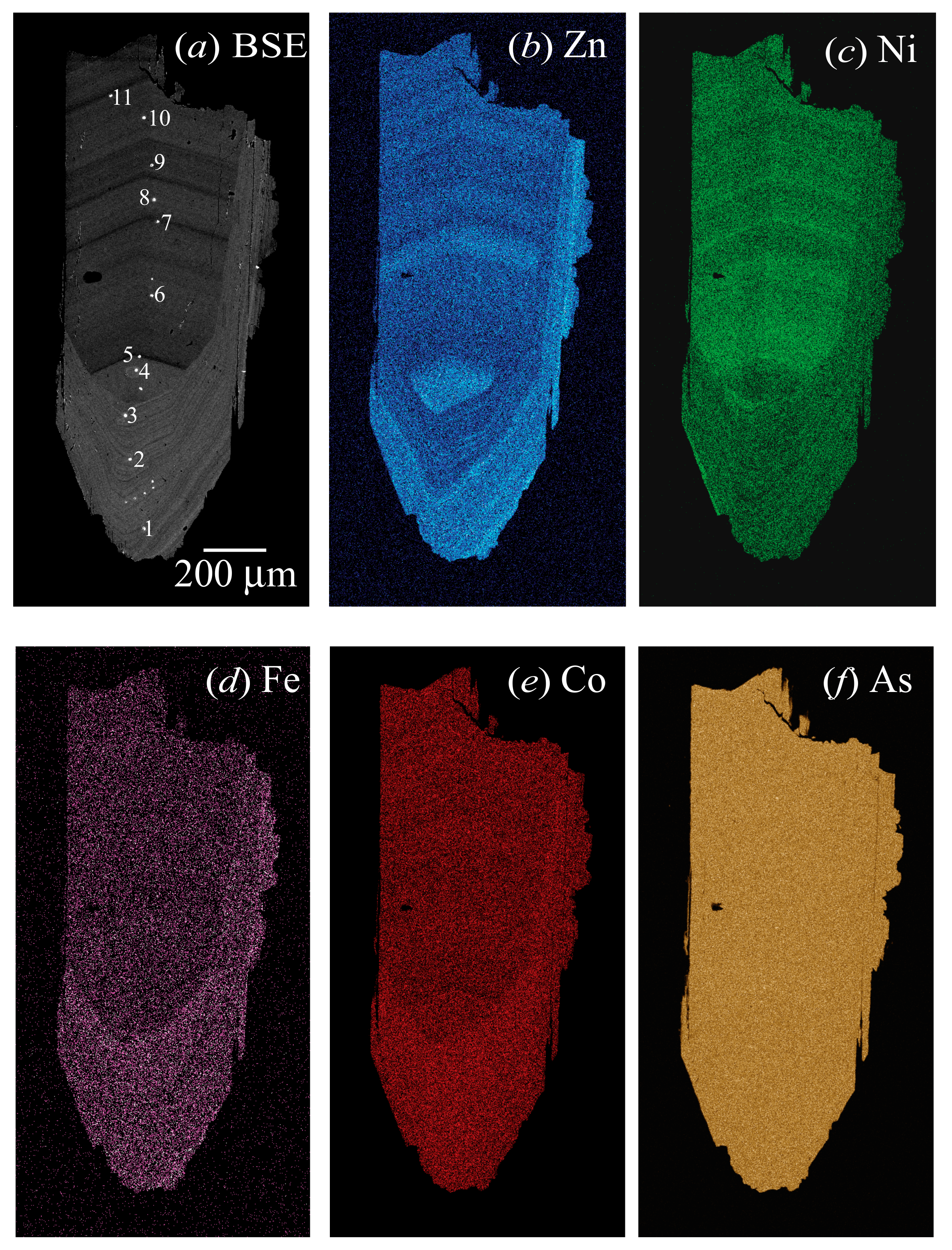
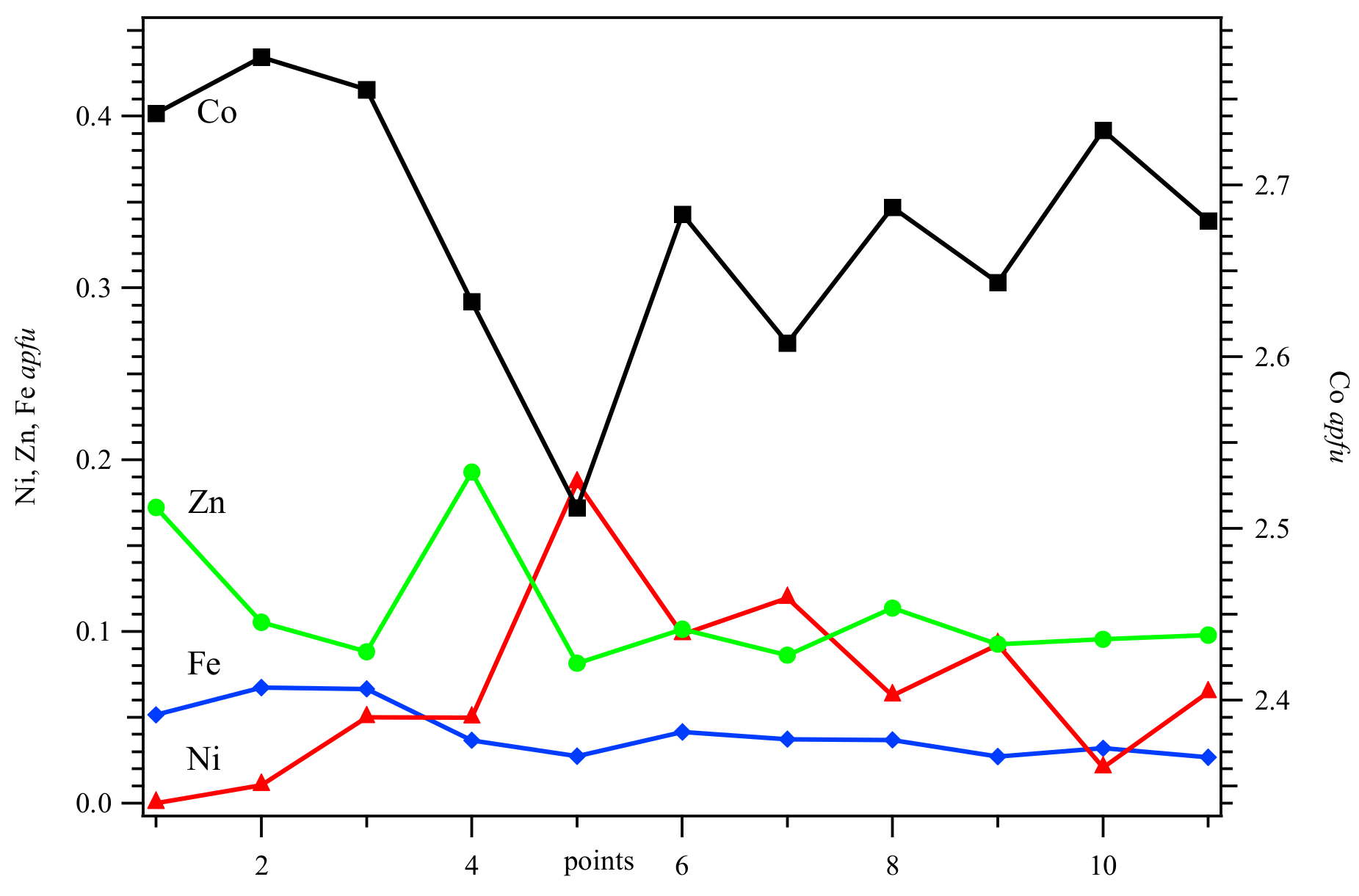
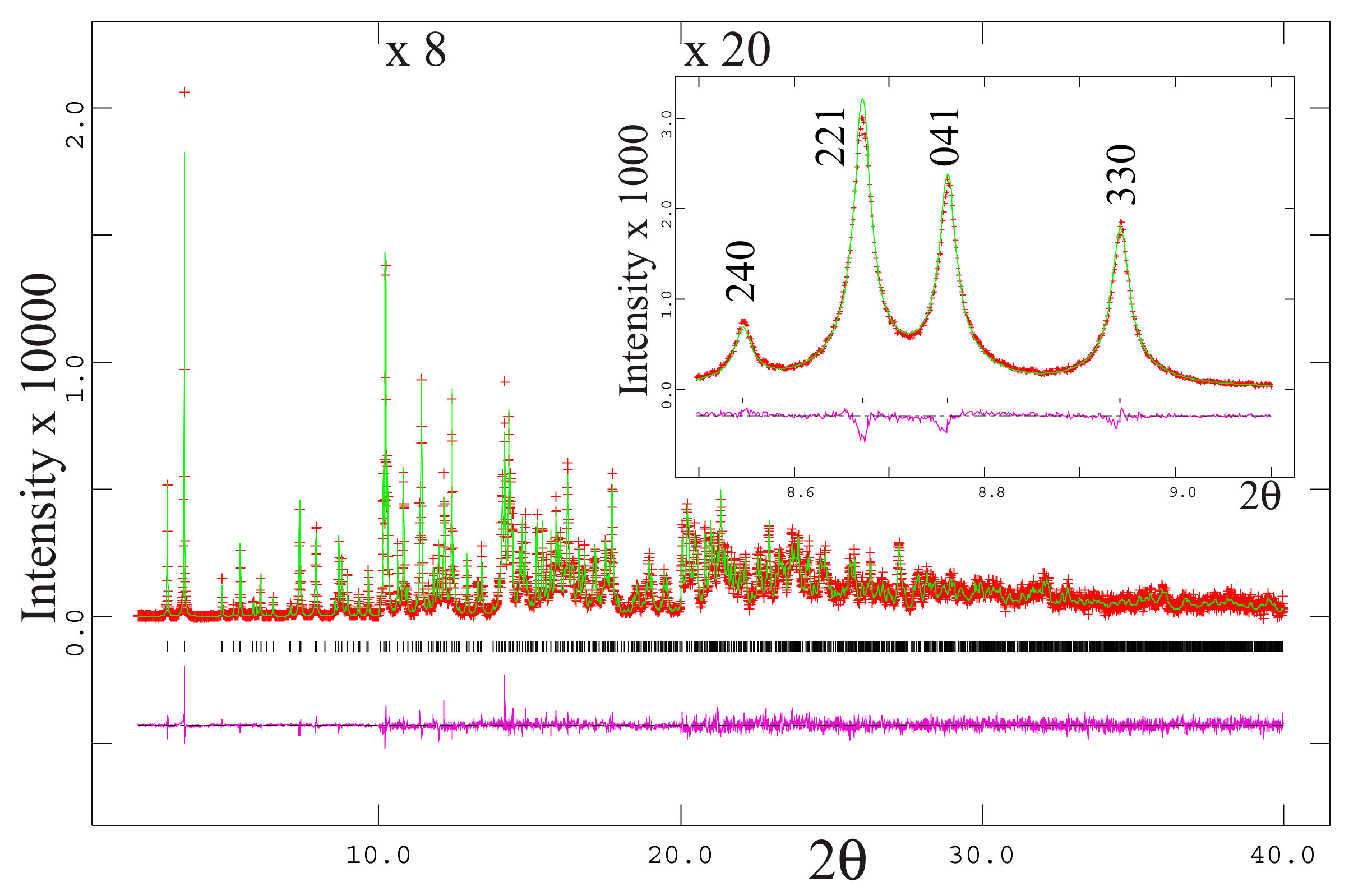
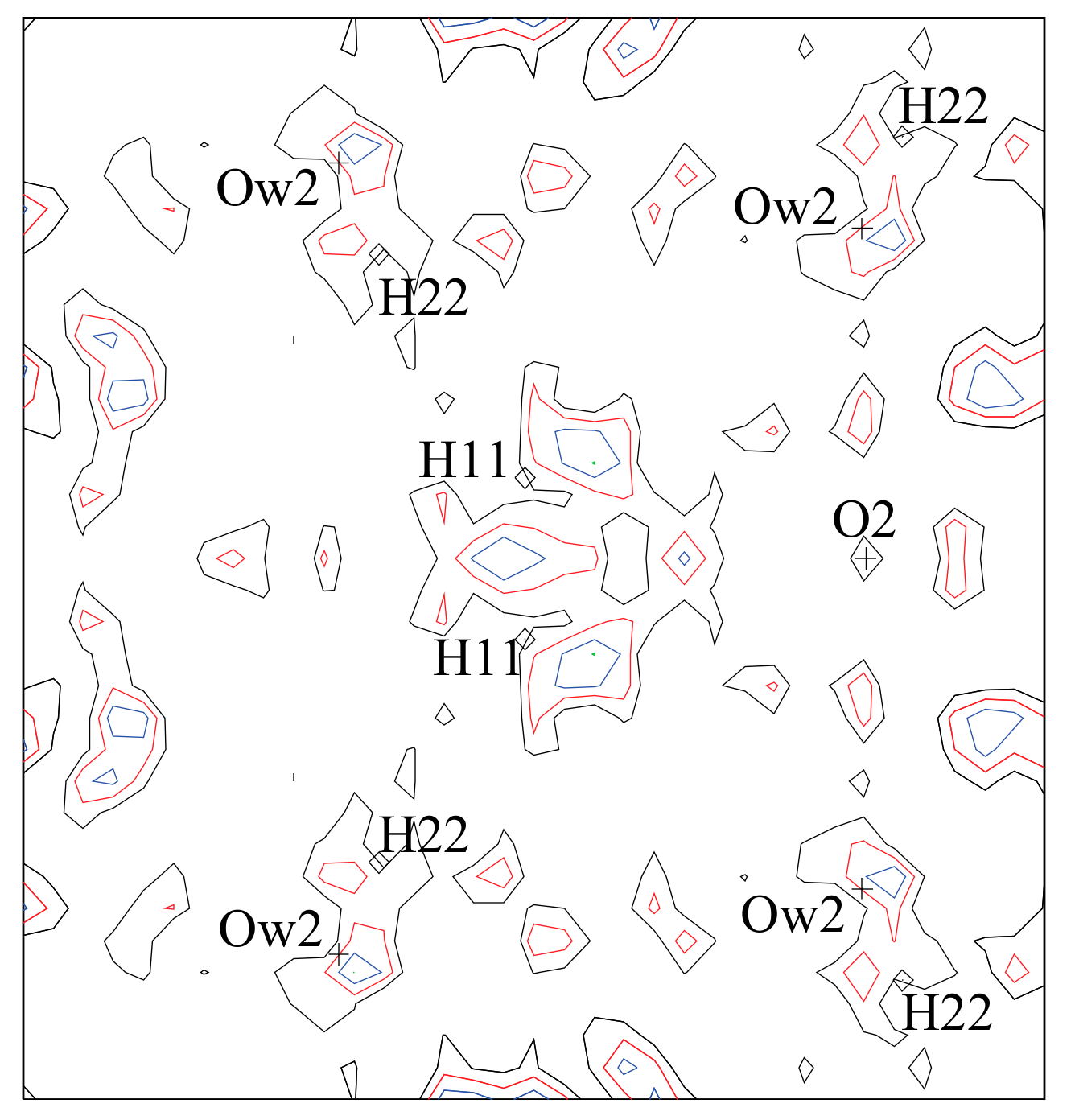
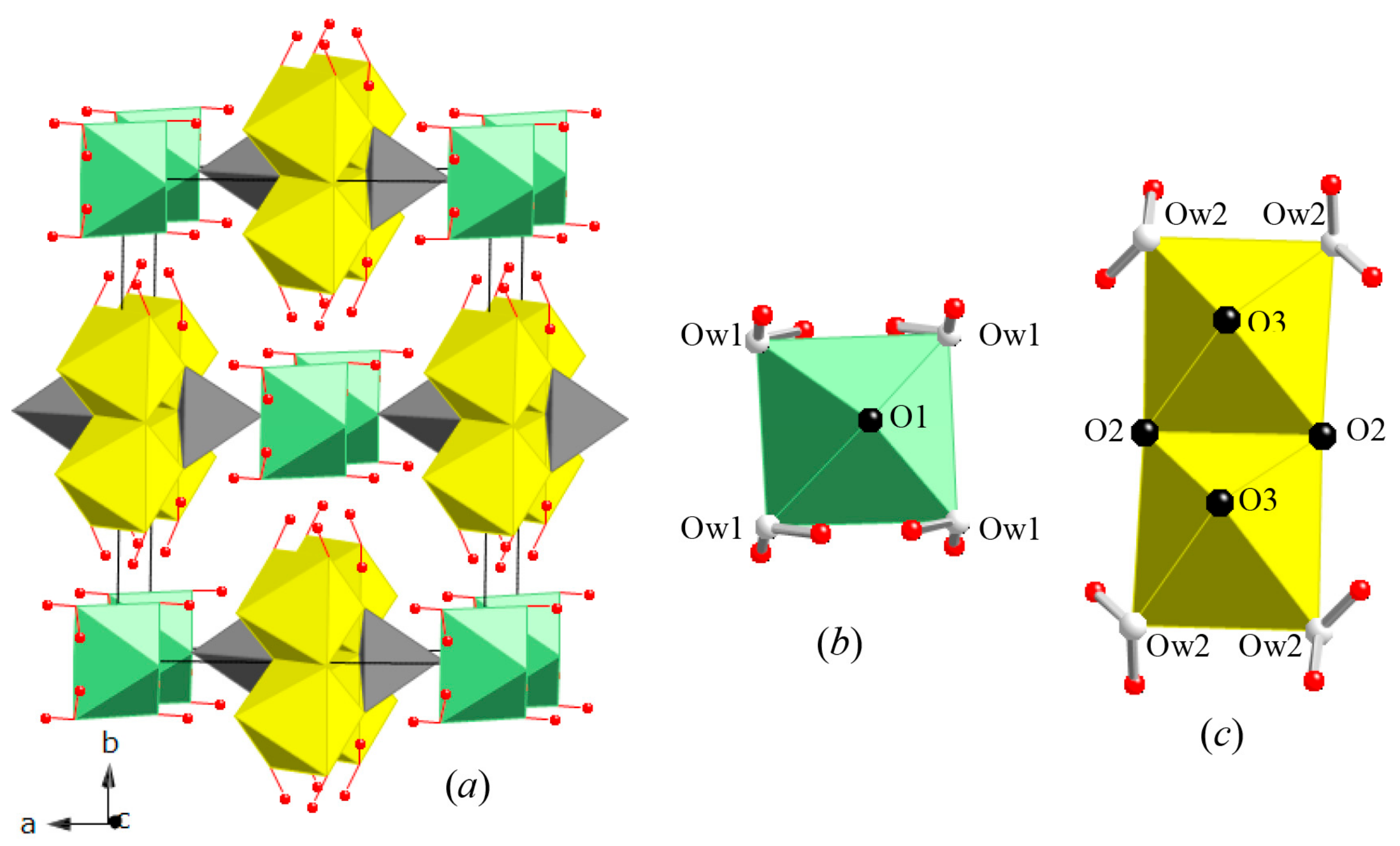

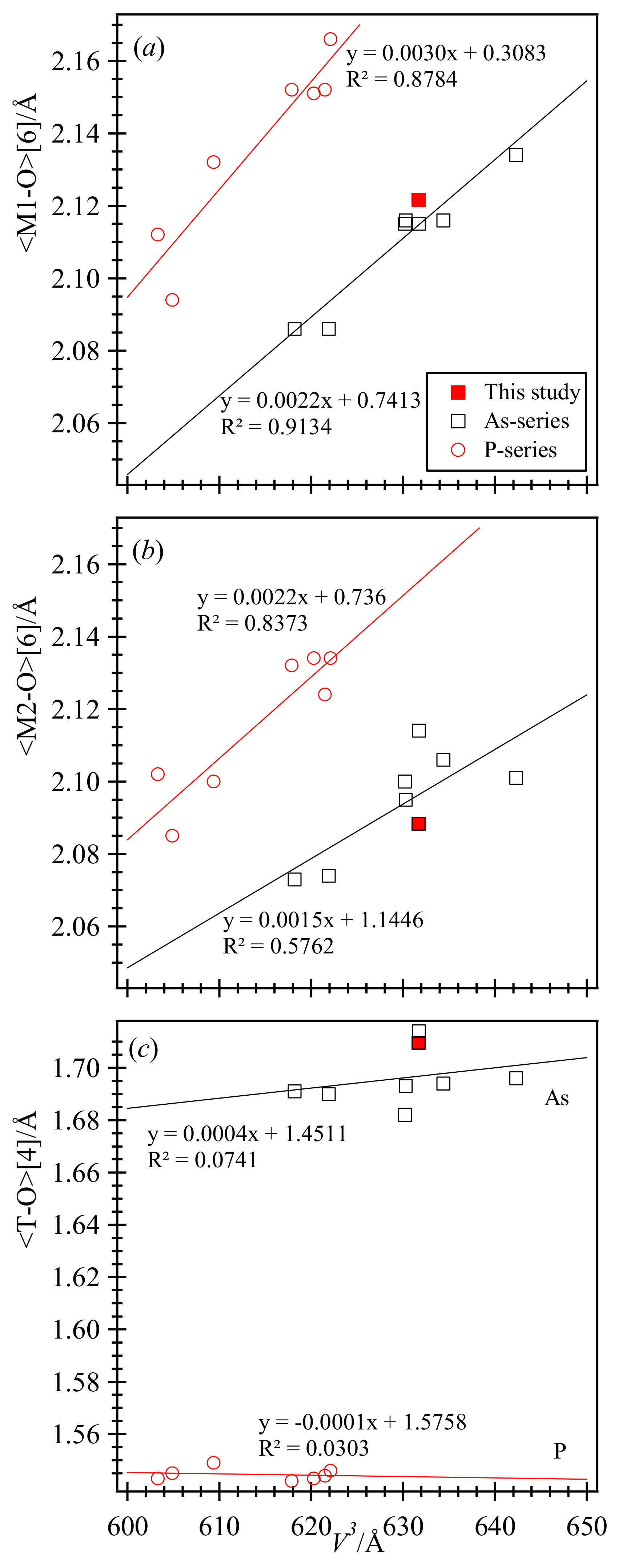
| Mineral | Composition | a/Å | b/Å | c/Å | β/° | V/Å3 | <M1–O> | <M2–O> | <T–O> | Reference |
|---|---|---|---|---|---|---|---|---|---|---|
| As-series | M3(AsO4)2·8H2O: M = | |||||||||
| annabergite | [Ni2.48Mg0.50Fe0.02] | 10.179 | 13.309 | 4.725 | 105.00 | 618.2 | 2.086 | 2.073 | 1.691 | [4] |
| cabrerite | [Ni2.2Mg0.7Fe0.1]3 | 10.211 | 13.335 | 4.728 | 104.97 | 621.9 | 2.086 | 2.074 | 1.690 | [5] |
| köttigite | [Zn2.44Co0.42Ni0.14] | 10.241 | 13.405 | 4.757 | 105.21 | 630.2 | 2.115 | 2.100 | 1.682 | [6] |
| Mg-erythrite | [Co2.16Mg0.60Ni0.24] | 10.187 | 13.470 | 4.755 | 104.97 | 630.3 | 2.116 | 2.095 | 1.693 | [7] |
| hörnesite | Mg3 | 10.26 | 13.44 | 4.74 | 104.90 | 631.6 | - | - | - | [8] |
| erythrite | [Co2.78Zn0.11Ni0.07Fe0.04] | 10.248 | 13.425 | 4.756 | 105.11 | 631.7 | 2.122 | 2.088 | 1.710 | This study |
| syn. hörnesite-annabergite ss | [Mg2.5Ni0.5] | 10.257 | 13.421 | 4.753 | 105.08 | 631.7 | 2.115 | 2.114 | 1.714 | [9] |
| hörnesite | Mg3 | 10.279 | 13.455 | 4.749 | 105.12 | 634.1 | - | - | - | [10] |
| erythrite | [Co2.01Fe0.74Ni0.25] | 10.251 | 13.447 | 4.764 | 104.98 | 634.4 | 2.116 | 2.106 | 1.694 | [4] |
| köttigite-parasymplesite ss | [Fe1.62Zn1.38] | 10.342 | 13.484 | 4.776 | 105.31 | 642.3 | 2.134 | 2.101 | 1.696 | [11] |
| parasymplesite | Fe3 | 10.35 | 13.52 | 4.79 | 104.90 | 647.7 | - | - | - | [12] |
| P-series | M3(PO4)2·8H2O: M = | |||||||||
| syn. pakhomovskyite | Co3 | 10.021 | 13.331 | 4.673 | 104.90 | 603.3 | 2.112 | 2.102 | 1.543 | [13] |
| pakhomovskyite | Co2.38Mg0.38Mn0.17Ni0.04Fe0.03 | 10.034 | 13.341 | 4.670 | 105.02 | 603.8 | - | - | - | [14] |
| syn. Mg-vivianite | Mg3 | 10.034 | 13.407 | 4.657 | 105.09 | 604.9 | 2.094 | 2.085 | 1.545 | [15] |
| barićite | [Mg1.70Fe2+1.19Fe3+0.11] | 10.085 | 13.39 | 4.671 | 104.96 | 609.4 | 2.132 | 2.100 | 1.549 | [16] |
| vivianite | Fe3 | 10.086 | 13.441 | 4.703 | 104.27 | 617.9 | 2.152 | 2.132 | 1.542 | [17] |
| vivianite | [Fe2.75Zn0.25] | 10.083 | 13.468 | 4.718 | 104.47 | 620.3 | 2.151 | 2.134 | 1.543 | [18] |
| vivianite | Fe3 | 10.116 | 13.473 | 4.706 | 104.33 | 621.5 | 2.152 | 2.124 | 1.544 | [18] |
| vivianite | [Fe2.88Mg0.12] | 10.1 | 13.494 | 4.709 | 104.24 | 622.1 | 2.166 | 2.134 | 1.546 | [18] |
| As2O5 wt % | 38.39 |
| SO3 | 0.06 |
| P2O5 | 0.00 |
| CoO | 34.89 |
| ZnO | 1.50 |
| NiO | 0.84 |
| FeO | 0.49 |
| MgO | 0.00 |
| H2O | 22.10 |
| ∑ | 98.25 |
| As apfu | 1.996 |
| S | 0.004 |
| P | 0.000 |
| ∑(As,S,P) | 2.000 |
| Co | 2.782 |
| Zn | 0.110 |
| Ni | 0.067 |
| Fe | 0.040 |
| Mg | 0.000 |
| ∑(Co,Zn,Ni,Fe,Mg) | 3.000 |
| H2O | 8.000 |
| a/Å | 10.24799(3) |
| b/Å | 13.42490(7) |
| c/Å | 4.755885(8) |
| β/° | 105.1116(3) |
| V/Å3 | 631.680(4) |
| Reduced χ2 | 1.227 |
| * R (F2) | 0.0313 |
| Data points | 38000 |
| Nobs | 3654 |
| λ/Å | 0.41397(2) |
| Site | sof | x | y | z | U |
|---|---|---|---|---|---|
| Co1 | 1.028(2) | 0 | 0 | 0 | 0.82(2) |
| Co2 | 0.912(2) | 0 | 0.38554(5) | 0 | 0.55(2) |
| As | 1 | 0.31639(5) | 0 | 0.3739(1) | 0.41(2) |
| O1 | 1 | 0.1489(3) | 0 | 0.3759(6) | 0.55(8) |
| O2 | 1 | 0.4055(3) | 0 | 0.7336(6) | 1.02(9) |
| O3 | 1 | 0.3437(2) | 0.1076(2) | 0.2091(4) | 0.70(5) |
| Ow1 | 1 | 0.0987(2) | 0.1151(2) | 0.8094(5) | 1.38(7) |
| Ow2 | 1 | 0.4000(2) | 0.2269(2) | 0.7163(5) | 1.51(7) |
| H11 | 1 | 0.088(2) | 0.076(2) | 0.686(5) | 0.3 |
| H12 | 1 | 0.187(2) | 0.121(2) | 0.946(5) | 0.3 |
| H21 | 1 | 0.377(2) | 0.185(2) | 0.528(5) | 0.3 |
| H22 | 1 | 0.437(3) | 0.277(2) | 0.701(5) | 0.3 |
| Co1–O1 | ×2 | 2.025(3) |
| Co1–Ow1 | ×4 | 2.170(2) |
| <Co1–O>[6] | 2.122(1) | |
| Co2–O2 | ×2 | 2.065(2) |
| Co2–O3 | ×2 | 2.096(2) |
| Co2–Ow2 | ×2 | 2.104(2) |
| <Co2–O>[6] | 2.088(1) | |
| As–O1 | ×1 | 1.719(3) |
| As–O2 | ×1 | 1.716(3) |
| As–O3 | ×2 | 1.702(2) |
| <As–O>[4] | 1.710(1) | |
| O1–As–O2 | ×1 | 105.5(1) |
| O1–As–O3 | ×2 | 106.69(8) |
| O2–As–O3 | ×2 | 110.50(7) |
| O3–As–O3 | ×1 | 116.3(1) |
| <O–As–O>[6] | 109.36(3) | |
| Ow1–H11 | 0.77(2) | |
| Ow1–H12 | 0.97(2) | |
| H11–Ow1–H12 | 119.3(2) | |
| H11–H12 | 1.51(3) | |
| H11....O1 | 2.02(2) | |
| H12....O3 | 1.77(2) | |
| Ow2–H21 | 1.03(2) | |
| Ow2–H22 | 0.78(2) | |
| H21–Ow2–H22 | 113.1(2) | |
| H21–H22 | 1.52(3) | |
| H21....O3 | 1.80(2) | |
| H22....Ow1 | 2.16(2) |
| Site | As | Co1 | Co2 | H11 | H12 | H21 | H22 | ∑(As,Co,H) |
|---|---|---|---|---|---|---|---|---|
| O1 | 1.139 | 0.414 | 0.213 | 1.979 | ||||
| O1 | 0.414 | |||||||
| O2 | 1.148 | 0.377 | 1.902 | |||||
| O2 | 0.377 | |||||||
| O3 | 1.192 | 0.350 | 0.279 | 0.271 | 2.092 | |||
| O3 | 1.192 | 0.350 | ||||||
| Ow1 | 0.293 | 0.806 | 0.653 | 0.184 | 1.936 | |||
| Ow1 | 0.293 | |||||||
| Ow1 | 0.293 | |||||||
| Ow1 | 0.293 | |||||||
| Ow2 | 0.343 | 0.612 | 0.797 | 1.752 | ||||
| Ow2 | 0.343 | |||||||
| ∑ | 4.671 | 2.000 | 2.140 | 1.019 | 0.932 | 0.883 | 0.981 |
© 2017 by the authors. Licensee MDPI, Basel, Switzerland. This article is an open access article distributed under the terms and conditions of the Creative Commons Attribution (CC BY) license (http://creativecommons.org/licenses/by/4.0/).
Share and Cite
Antao, S.M.; Dhaliwal, I. Growth Oscillatory Zoning in Erythrite, Ideally Co3(AsO4)2·8H2O: Structural Variations in Vivianite-Group Minerals. Minerals 2017, 7, 136. https://doi.org/10.3390/min7080136
Antao SM, Dhaliwal I. Growth Oscillatory Zoning in Erythrite, Ideally Co3(AsO4)2·8H2O: Structural Variations in Vivianite-Group Minerals. Minerals. 2017; 7(8):136. https://doi.org/10.3390/min7080136
Chicago/Turabian StyleAntao, Sytle M., and Inayat Dhaliwal. 2017. "Growth Oscillatory Zoning in Erythrite, Ideally Co3(AsO4)2·8H2O: Structural Variations in Vivianite-Group Minerals" Minerals 7, no. 8: 136. https://doi.org/10.3390/min7080136





